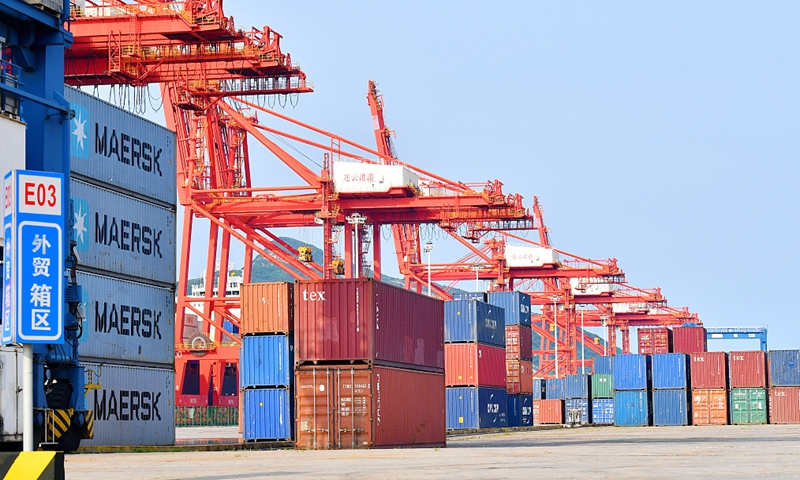The Chinese economy ended what has been a year of unprecedented challenges for mankind brought about by a deadly virus on an astonishingly high note, with growth in the final quarter of 2020 returning to pre-pandemic levels, lifting the country to several milestones of national pride. China became the only major economy to record growth last year with a 2.3 percent growth and its GDP climbed over the 100 trillion yuan mark for the first time ever, official data showed on Friday.
The remarkable comeback offered the most comprehensive testament to the resilience of the world’s second-largest economy and the effectiveness of the Chinese system in containing the virus and stabilizing the economy – in stark contrast to chaotic scenes seen in the US and other Western nations. It also provided a boost to China’s confidence in the face of lingering challenges ahead, while dealing a direct blow to certain Western forces that have spared no efforts in their attempt to smear China and contain China’s rise.
However, the impressive figures did not erase the massive economic loss the deadly virus has caused to the Chinese economy, whose growth was the slowest in over four decades, and the extreme hardship it brought to small businesses that struggled or even closed permanently, as well as consumers, who have been forced to cut back on their spending.
As China marks several crucial moments in 2021, which is the start of the next five-year plan and the next centennial goal of building a modern socialist power, addressing those challenges and an array of other risks – from sporadic outbreaks of the COVID-19 and a deep domestic economic transition, to worsening global economic conditions and geopolitical tensions – would be front and center in policymaking this year, analysts said.
New milestone
In the fourth quarter of 2020, the Chinese economy grew by 6.5 percent year-on-year, the National Bureau of Statistics (NBS) said on Monday, a stunning recovery from the historic 6.8 percent contraction in the first quarter when the novel coronavirus forced much of the country to a virtual halt.
That pace is also higher than the 6 percent growth in the final quarter of 2019 before the epidemic and lifted full-year growth to 2.3 percent, according to the NBS.
China “is expected to become the only major economy in the world to achieve positive growth,” Ning Jizhe, director of NBS, told a press briefing on Monday, adding that the achievement further cemented China’s position as the world’s second-largest economy and leading global growth driving force, accounting for 17 percent of the world’s total GDP.
The solid recovery also lifted China’s GDP, at 101.6 trillion yuan ($15.67 trillion), to a new milestone of reaching the 100 trillion yuan mark – an important gauge of the success of China’s social and economic development policies over the past several years. “That means our country’s economic strength, scientific and technological capabilities and overall national strength have jumped to a new level,” Ning said.
While official data for 2020 have not been released by all major economies, the World Bank said in a report on January 5 on global economic prospects that the US economy is expected to contract by 3.6 percent in 2020, and the eurozone’s GDP to shrink by 7.4 percent. Overall, the global economy is expected to decline by 4.3 percent, according to the report.
What had made China take the lead in the global recovery from the pandemic was its swift and effective response to the COVID-19, both in terms of stemming the virus and restarting economic activities, analysts noted.
“The Chinese government’s strong anti-coronavirus measures that effectively contained the spread of the virus, the flexible counter-cyclical macroeconomic policies, as well as the efforts taken to deepen reform and opening-up to the outside world, contributed to the better-than-expected economic results in 2020,” Cao Heping, a professor at the School of Economics of Peking University, told the Global Times on Monday.
In retrospect, when China dealt with the epidemic head on during the first quarter of 2020 which effectively brought the country to a virtual halt, many Western countries, led by the US, mounted a smear campaign against China’s political, social and economic system; when China effectively reined in the pandemic and gradually restarted economic activities, some Western countries failed to contain the virus and remained in social and political chaos.
Lingering challenges
However, even as the success offered a source of pride and confidence for many Chinese, there also remains a slew of challenges and hardships that need to be addressed to further consolidate the country’s hard-fought gains.
Despite the solid recovery, a 2.3 percent growth in 2020 represents the slowest pace for the Chinese economy since 1976 and was significantly lower than the 6 percent growth in 2019. That could translate into trillions of yuan in lost economic output and ultimately the struggles of both businesses and consumers.
Reflecting the hardship, retail sales – a key gauge of consumption – dropped 3.9 percent year-on-year in 2020, as consumers cut back spending during the challenging times. Specifically, the catering sector saw the biggest drop of 16.6 percent in revenues, as they were forced to close or consumers were restricted to eat out as part of the country’s anti-epidemic efforts. Also pointing to the weak domestic consumption is a 0.7 percent decline in imports, compared to a 4 percent growth in exports.
That is significant because consumption has become the biggest driving force for the Chinese economy, and policymakers are counting on further boosting the massive domestic consumption to ensure steady and sustainable growth for years to come.
“To realize the domestic market’s consumption potential, prudent monetary policies should remain this year to enable small and medium-sized enterprises to have access to ample funds, as they create about 90 percent of jobs in the country,” said Yu Miaojie, deputy dean with the National School of Development at Peking University, noting that taxation and fee cuts are also necessary to increase people’s disposable incomes.
Apart from the slow recovering in consumption, China also faces other challenges, including new outbreaks of the COVID-19 in several areas, lingering tensions with the US in trade and technology, and a seriously disrupted global supply chain, analysts pointed out.
In recent meetings, including the Central Economic Work Conference held in November 2020, Chinese officials stressed the need to address those challenges under the new “dual-circulation” strategy, which puts heavy focus on boosting the domestic market to cope with mounting risks. More measures could further boost consumption and the manufacturing sector in an effort to further consolidate the recovery from the COVID-19 epidemic and ensure a steady start of China’s pursuit of new social and economic development goals, analysts noted.
China’s experience and confidence in handling not just the COVID-19 but also other challenges following the achievements in 2020 also foreshadow a promising outlook for the Chinese economy in 2021, when other major economies are still expected to face tough times, analysts added.
“In 2021, China’s economy is expected to rise strongly in the first and second quarters, and then return to the long-term central levels. Annual growth is expected to be around 9.2 percent,” ICBC International economists Cheng Shi and Wang Yuzhe wrote in a research note to the Global Times on Monday.
GDP photo: VCG



